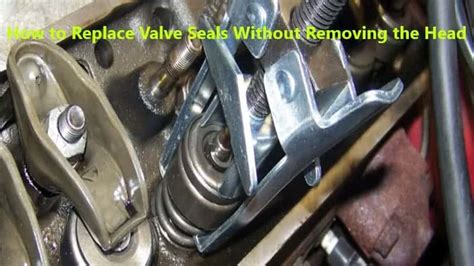How To Remove Valve Seals
Ronan Farrow
Apr 02, 2025 · 3 min read

Table of Contents
How to Remove Valve Seals: A Comprehensive Guide
Replacing valve seals is a crucial maintenance task for any internal combustion engine. Worn-out seals lead to oil leaks, reduced engine performance, and potential damage to the catalytic converter. While this might sound daunting, with the right tools and a methodical approach, you can successfully remove valve seals yourself. This guide provides a detailed walkthrough, focusing on safety and efficiency.
Tools You'll Need:
Before you begin, gather all necessary tools. Improvisation can lead to damage and frustration. You'll need:
- Valve Spring Compressor: This is arguably the most important tool. It safely compresses the valve springs, allowing access to the seals. Choose a compressor appropriate for your engine's valve size.
- Socket Set: A variety of sockets will be needed to remove the rocker arms, valve covers, and potentially other components.
- Wrench Set: Similar to the socket set, wrenches are essential for various fasteners.
- Screwdrivers: Flathead and Phillips head screwdrivers might be needed for various tasks.
- Valve Seal Installer/Remover: These specialized tools make the job much easier and minimize the risk of damaging the new seals. While not strictly required, they are highly recommended.
- Clean Rags: Keep your workspace clean to avoid contaminating engine components.
- Shop Towels: These are absorbent and useful for cleaning oil.
- Gloves: Protect your hands from grease and oil.
- Safety Glasses: Protect your eyes from debris.
- Engine Manual: A service manual specific to your vehicle is invaluable. It provides detailed diagrams, torque specifications, and procedural steps.
Step-by-Step Guide to Removing Valve Seals:
Disclaimer: This guide provides general steps. Consult your vehicle's service manual for specific procedures and torque specifications. Incorrect procedures can cause significant engine damage.
1. Preparation:
- Disconnect the Battery: This prevents accidental shorts and protects electronic components.
- Drain Engine Oil: This is crucial to minimize oil spillage during the process.
- Remove the Valve Covers: Access to the valve train is necessary. Follow your service manual for proper removal and bolt torque specifications.
- Remove Rocker Arms: Carefully remove and set aside the rocker arms, keeping track of their positions.
2. Compressing the Valve Springs:
- Position the Compressor: Carefully position the valve spring compressor on the valve spring. Ensure it's securely attached and properly aligned.
- Compress the Spring: Slowly compress the valve spring until you have enough clearance to access the valve seal.
3. Removing the Valve Seal:
- Use a Seal Remover (Recommended): A valve seal remover tool is the safest and most effective method. Follow the manufacturer's instructions for its use.
- Manual Removal (Less Recommended): If you don't have a remover, you can try using a small, flat, blunt tool to carefully pry the seal out. Be extremely careful to avoid scratching or damaging the valve stem.
4. Reassembly (After Installing New Seals):
- Install New Seals: Use a seal installer tool to ensure the new seals are properly seated.
- Release the Valve Spring Compressor: Slowly release the spring compressor, ensuring the valve stays closed.
- Reinstall Rocker Arms: Reinstall the rocker arms in their original positions, tightening to the specified torque.
- Reinstall Valve Covers: Carefully reinstall the valve covers and tighten to the specified torque.
- Refill Engine Oil: Refill the engine with the correct type and amount of oil.
- Check for Leaks: After running the engine, inspect for any oil leaks.
Tips for Success:
- Work in a Clean Environment: A clean workspace minimizes the risk of contamination.
- Take Your Time: Rushing can lead to mistakes and damage.
- Use the Right Tools: The correct tools are essential for a safe and efficient repair.
- Consult Your Service Manual: The service manual is your best resource for detailed instructions.
Replacing valve seals requires patience and precision. By following these steps and exercising caution, you can successfully complete this important maintenance task and keep your engine running smoothly. Remember, always prioritize safety and consult your vehicle's service manual for specific instructions.
Featured Posts
Also read the following articles
| Article Title | Date |
|---|---|
| How To Soft Wash Vinyl Siding | Apr 02, 2025 |
| How To Tighten Ball Hitch | Apr 02, 2025 |
| How To Sanitize Mead Equipment | Apr 02, 2025 |
| How To Refurbish Aluminum Wheels | Apr 02, 2025 |
| How To Pull A Tube Without A Tow Bar | Apr 02, 2025 |
Latest Posts
-
How To Write A Novel For Beginners Pdf
Apr 03, 2025
-
How To Write A Navy Eval
Apr 03, 2025
-
How To Write A Letter Of Interest For Residency
Apr 03, 2025
-
How To Write A Character With Depression
Apr 03, 2025
-
How To Write A 10 Minute Play
Apr 03, 2025
Thank you for visiting our website which covers about How To Remove Valve Seals . We hope the information provided has been useful to you. Feel free to contact us if you have any questions or need further assistance. See you next time and don't miss to bookmark.
